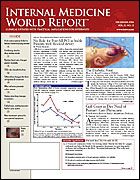Of Shrinking Men and Broken Bones
From the American Society of Bone and Mineral Research
PHILADELPHIA—Loss of height is a strong predictor of hip fracture in elderly men. As such, it can be a simple, sensitive, and useful screening test for evaluating fracture risk.
In a study of 5995 men aged ≥ 65 years, Steven R. Cummings, MD, FACP, and colleagues correlated men’s height loss with fracture risk during the first 4.7 years of a planned 5-year study. Height loss was calculated by subtracting height measurements at study entry from the men’s self-reported height at age 25. The men were then stratified by quartiles of <2 cm, 2 to 4 cm, 4 to 6 cm, and >6 cm of height loss. Dr Cummings, of the University of California San Francisco and director of the San Francisco Coordinating Center, reported these findings at the American Society of Bone and Mineral Research annual meeting.
The incidence of nonspine and hip fractures paralleled increases in height lost. During the study, there were 413 nonvertebral and 77 hip fractures. Incidences of hip fracture were 0.52%, 0.58%, 1.51%, and 3.69% over 4.7 years for the <2 cm, 2 to 4 cm, 4 to 6 cm, and >6 cm quartiles, respectively. Assigning a relative risk of 1 for a height loss <2 cm, relative risks of hip fracture were 1.9, 3.9, and 7.3 for each successive quartile. Relative risks for nonspine fractures were 1.1, 1.6, and 2.2, respectively. The results were controlled for exercise, weight, smoking, and ethnicity—none of which accounted for the findings.
Height loss correlated well with age-adjusted mean femoral neck bone mineral density (BMD). For each increasing quartile of height loss (<2 cm to >6 cm), the correlating BMD measurements were 0.795 g/cm2, 0.79 g/cm2, 0.782 g/cm2, and 0.761 g/cm2, respectively.
Results showed that men who lose >6 cm and have low hip BMD would have an approximate 8% risk of hip fracture over 5 years (Figure). “That’s extraordinarily high,” Dr Cummings said. “By comparison, men who have lost less than 2 cm essentially hadn’t lost height, rarely had hip fractures—less than 0.2% [incidence].” In men with the least height loss, fracture risk was low, regardless of BMD.
A total of 43% of all hip fractures occurred in men with a >6 cm height loss, and another 25% of fractures occurred in men who lost 4 to 6 cm of their height.
Physicians often do not measure elderly men’s height, even though it is easy to get an accurate reading. “I hope that people now begin to pay attention to height loss as a manifestation of osteoporosis, but particularly as a marker of risk of its most serious consequence,” he said. “It’s cheap, easy, and very powerful.”
Dr Cummings suggested that multiple factors besides vertebral fractures may contribute to height loss. “It might be that height loss is a sign of frailty… and this simple measure of height loss is a good measure of developing frailty, and hip fractures are one of the manifestations of being frail.” Other possible contributors to height loss are desiccation of intervertebral discs, changes in connective tissues, and loss of paravertebral muscle tone.
Although the association between height loss and fracture risk has been investigated in women, Dr Cummings said this is the first study to evaluate the relationship in men. In women, height loss predicts fracture risk, but not as strongly as in men.
He recommends calculating how much height a man has lost since age 25. Minimal loss (<2 cm) indicates a low risk for hip fracture. “If they have lost height, that’s a person who should have a measurement of bone density at the hip,” he said. “The combination of 4 to 6 cm of height loss and a bone density in the lowest third means that’s a person that ought to be treated for prevention of fracture.”
The combination of a hip bone density measurement and height loss is as a “strong, good predictor of hip fracture risk [as] any combination of factors I’ve yet seen in men,” Dr Cummings said.
